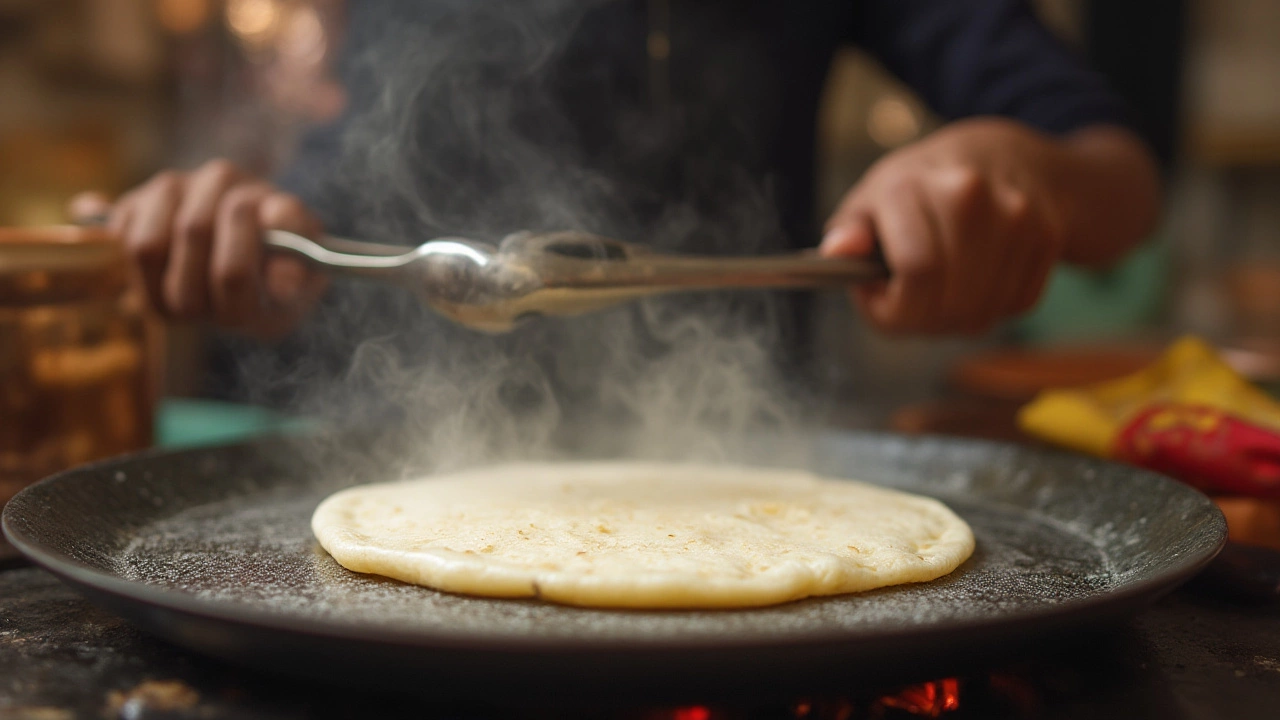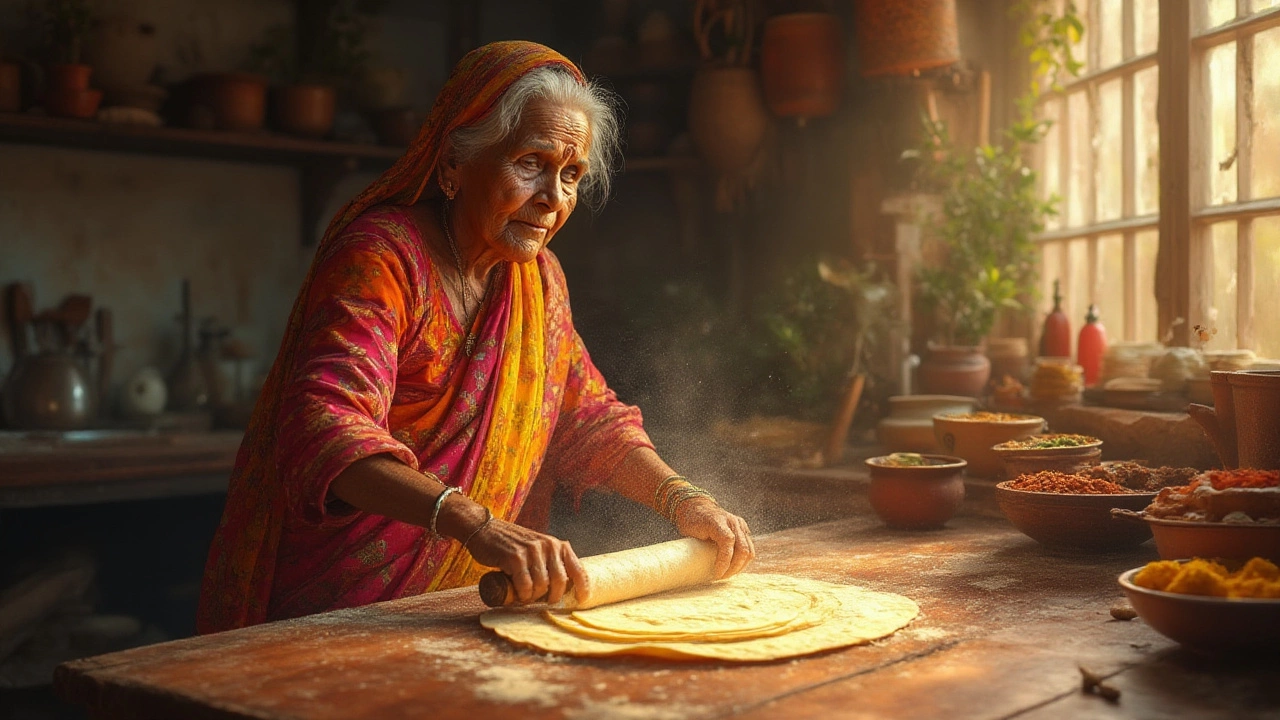There’s just something magical about watching a roti balloon up on a hot tawa, almost like it’s showing off. But let’s be honest—it’s a bit of a kitchen heartbreak when your carefully rolled roti stays flat as cardboard. So what’s the secret behind that dramatic puff? It’s not luck. It’s science, technique, and that little bit of extra care that transforms a round of dough into a soft, airy cloud. Turns out, making your rotis puff up isn’t about impressing anyone (although, okay, it totally does); it’s about nailing a few precise steps you might not have realized matter so much. And—believe me—it’s more doable than you think.
The Science Behind Puffing Rotis
Rotis puff up because of steam—plain and simple. But what’s less known is why some rotis act like little hot air balloons while others just lie there. First, it’s about gluten: when you knead your dough well, gluten chains build structure, trapping air and steam. That’s why if you skimp on kneading, your roti sits limp and sad. Moisture is the next big player. Too much water, and the dough becomes sticky; too little, and it dries out, making puffing almost impossible. The magic ratio is about 1 cup of whole wheat flour to just under a half cup of water.
The real show happens when the rolled-out roti hits the hot pan. The lower layer cooks and seals, while the inside gets hotter and turns moisture into steam. Once you flip it, the steam pushes against the cooked layer, and—pop—it puffs! If your heat isn’t high enough, there isn’t enough steam pressure, and nothing much happens. Too hot, and the roti burns before the inside steams up. Cooking temperature needs to be right in that sweet spot: around 230°C (or the medium-high setting on most stovetop burners). Think of the tawa (griddle) as a stage; it should always be preheated properly, something that home cooks so often skip.
Why bother about the science bit? Because when you know what’s really going on, it’s easier to change things up if your rotis aren’t puffing: Is the dough too dry or stiff? Is your pan hot enough? Is your flipping timing off? Numbers back this up—according to a 2022 survey run by an Indian cooking site, 70% of home cooks who adjusted their water ratio and preheated their tawa every time saw a dramatic improvement in roti puffing within three tries. It’s not magic; it’s cause and effect.
Perfect Dough: More Than Just Mixing Flour and Water
The dough is the backbone of any roti that wants to puff. Here’s the thing: even the fanciest tawa or rolling pin can’t save poorly made dough. Start with good quality atta (whole wheat flour). The right flour is not just about flavor; its gluten content matters more than you think. Indian whole wheat is a bit coarser and higher in protein compared to Western brands, which makes a big difference to how the dough holds steam. If you’re using supermarket flour and struggling, try an Indian grocery store for authentic atta.
Add water slowly. Never dump it all in at once; you’ll end up with lumps that never break down. Mix with your fingers, not with a spoon—a spoon can’t feel the stickiness and softness you need. You want soft, slightly tacky dough, not something that leaves residue on your hands. After mixing, give your dough time to rest. Cover it with a damp cloth and let it sit at least 20 minutes. This little nap lets the flour absorb water evenly and the gluten relax, which makes rolling easier and cooking more uniform.
If your kitchen is dry (hello, British winter), add an extra teaspoon of water and up the resting time. You’ll notice a difference in the springiness and softness of the rotis. And here’s a quirky fact for the overachievers: a few drops of oil or even warm milk in the dough can make it even softer and boost puffing. But don’t go overboard—a tablespoon per two cups of flour is plenty. Remember, kneading is not a quick job. Set a timer for at least 8-10 minutes; that’s how you get the right *feel* for the dough.

Rolling and Shaping: Thin Enough, but Not Too Thin
This is where so many rotis go wrong. Rolling doesn’t just give your flatbread a pretty round shape—its thickness and evenness decide whether steam can build up inside or escapes out the edges. Aim for about 2 mm thickness; think thin, but not papery. If you roll it out too thick, it won’t cook quickly enough for the steam to puff it up. Too thin, and the roti just dries out and cracks. Try to keep your rolling motion gentle. Press down hard and the dough sticks to the board or breaks at the edges, making cracks for the steam to escape.
A lot of people struggle to keep rotis round. If your rotis come out Dali-esque, don’t stress. Shape isn’t as important as consistency in thickness. Turning the dough a quarter turn with each roll stops it sticking and keeps those edges even. Dusting the board and rolling pin with flour helps—just don’t overdo it, or your rotis may turn out tough from extra dry flour on the surface. Instead, give each ball a quick touch of flour, shake off the excess, and get rolling. Pro tip: flatten the dough balls before you start rolling for a more even disc.
If the edges keep drying out and cracking, it means the dough’s not moist enough—or maybe your kitchen air is too dry. Covering the extra dough balls with a damp tea towel while you work solves this problem easily. Want a trick from my family in Lucknow? After rolling out halfway, flip the roti and roll from the other side. This gives you a more even disc and helps puffing.
Getting the Heat and Technique Right
Heat and cooking timing are make-or-break. The tawa/pan should be medium-high hot before you even start. Here’s a little test: sprinkle a few drops of water on the tawa—if they sizzle and evaporate right away, it’s ready. If they just sit there, your pan needs more time. Avoid nonstick pans for this (yes, really!); cast iron or steel give the best results because they distribute heat evenly and get hot enough to produce steam.
Once your roti’s on the tawa, don’t walk away. Give it about 20 seconds, then flip—the underside should have light brown spots. After flipping, let the other side take on a few brown speckles too (about 20-25 seconds). Now comes the moment for puffing: pick up the roti gently with tongs and place it directly over the flame (or on the hottest part of your pan if you have an electric stove). The steam trapped inside now builds up quickly and, if your rolling and dough are right, it will balloon right up. Flip it quickly if needed for even puffing.
If you don’t have a gas flame, you can press gently with a clean tea towel or a spatula on the cooked roti while it’s on the hot tawa. This pushes steam into the uncooked layers, helping it puff up. But be careful—press too hard and the roti tears, letting out the steam. According to a test in BBC Good Food India, rotis cooked on gas flames puffed 30% more successfully than those left on electric hobs, but you can get very close with careful pressing and quick flipping.

Common Mistakes, Fixes, and Fun Roti Facts
Why do rotis sometimes stubbornly refuse to puff? The main culprits are too little kneading, dry dough, uneven rolling, or a not-hot-enough tawa. Check your dough first: if it’s dry or feels tough, add a spoonful of water and knead again. If rolling is the issue, try making your discs a bit thicker and more uniform. And don’t forget the hot tawa—inconsistent heat is the number one killer of puffy rotis.
Stacking rotis after cooking is also key. Immediately after making, wrap them in a clean, dry kitchen towel. This keeps them warm and prevents drying out as the steam inside finishes softening the bread. If you leave them uncovered, even for a minute or two, they toughen up. Another tip—don’t crowd the pan. If you’re making rotis for a crowd (that’s when the pressure is highest, right?), cook one or two at a time for best puffing.
Did you know the biggest roti ever made weighed more than 145 kg? It was measured in Jamnagar, India during a food festival in 2003. Most of us don’t need rotis that size, thankfully! But here’s a more practical fact—in north India, restaurants add a tiny bit of milk or yogurt to their dough to keep rotis softer for longer. In Maharashtra, some use a pinch of sugar for extra brown color.
| Key Roti Puffing Factors | Success Rate (Based on Home Cooks) |
|---|---|
| Kneading Dough 10 min | 67% |
| Resting Dough 20+ min | 84% |
| Preheated Tawa | 90% |
| Gas Flame vs Electric | Gas: 95%, Electric: 68% |
| Soft Dough with Proper Hydration | 87% |
Keep experimenting. Every kitchen is a little different, and sometimes, so is the flour or even the water hardness. Once you master the rhythm, seeing that roti puff up never gets old. And honestly, if you’ve ever been cheered for it by family or friends (or just quietly celebrated with a plate of fresh, hot chapatis), you know exactly what I mean. So, keep at it—the next perfect puff is just a batch away!
